Click on the images to see a larger version and the back of the wing/badge
|
Following are wings sent in by site contributors that are of an unknown origin. None of these wings are part of my personal collection so, unfortunately, I can't send any more detailed photos of them. If anyone can identify any wing displayed and what it was used for please email me at bschwartz@ww2wings.com. All of the descriptions have been sent in by the owner of the badge. I have not personally handled any of these badges so the only information I can provide is what has been provided to me.
|
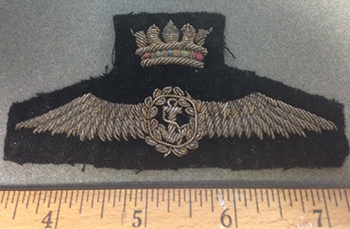
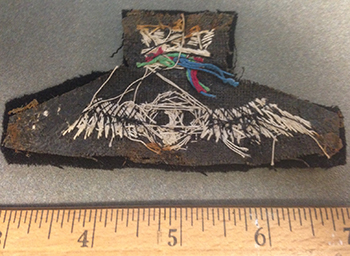
Added: 5/6/2020 - click on the image for larger versions
This wing came out of Australia. No clue what it is.
|
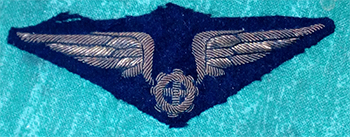
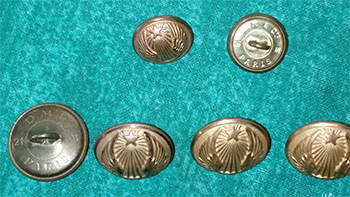
Added: 5/6/2020 - click on the image for larger versions
The buttons are made in Paris by two different manufacturers, the smaller are 16mm and the larger 21mm.
IDENTIFIED on 12/27/2020 by Tod Ratbhone - The winged gear is a French Air Force (armée de l'air) branch of service device denoting mechanic personnel. Worn on right breast above pocket. This insignia was instituted in the 1930s and still in use today. Flying personnel have the same device but with a star. The buttons are standard French Air Force buttons.
|
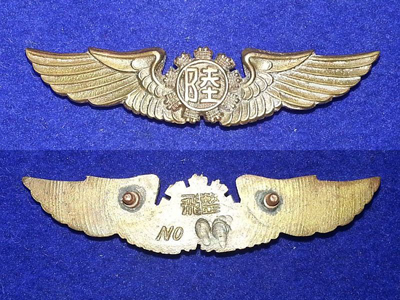
Added: 9/27/2014 - click on the image for larger versions
Possibly a Chinese Air Force Flight Engineer / Crew Chief wing? Input is welcome.
|
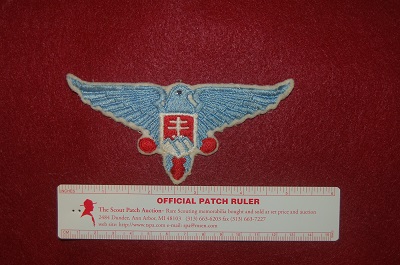
Added: 9/27/2014 - click on the image for larger versions
IDENTIFIED on 11/24/2019 by Robert Egeric -It's a Slovak sport association badge.
|
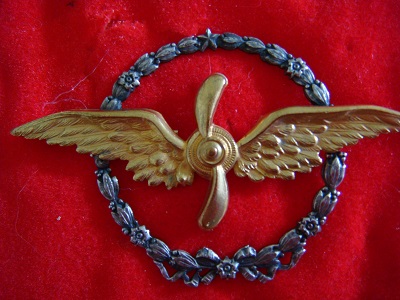
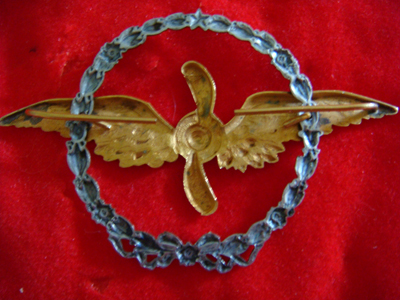
Added: 9/27/2014 - click on the image for larger versions
Possibly French? Input is welcome.
|
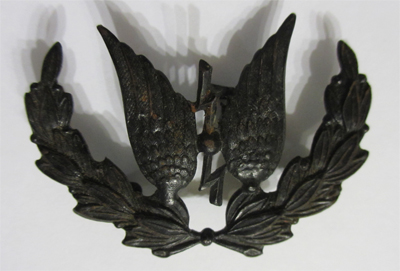
Added: 7/6/2014 - click on the image for larger versions
It was found in amongst the contributor's late father’s RAAF badges and insignias. He was an RAAF WAG during WW2. The badge is 50mm wide and 35mm high with 3 badge holding loops/pins.
IDENTIFIED on 5/6/2020 by Steve Conway - the badge is a WW1 Australian Army Wireless Operators trade badge according to this website:
http://www.diggerhistory.info/pages-badges/trade.htm
|
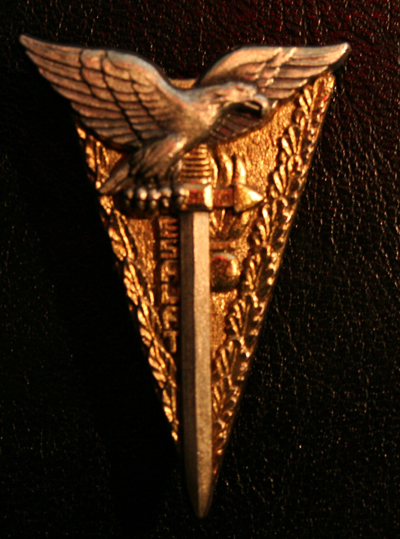 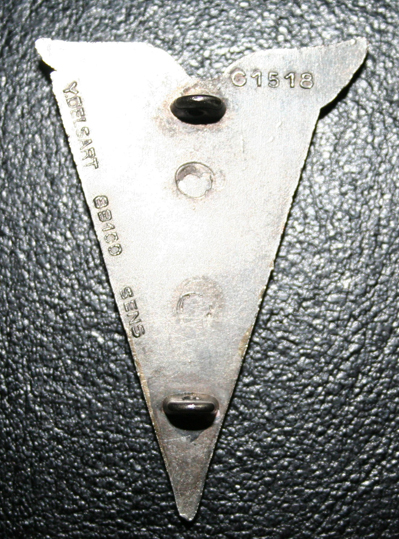
Added: 7/6/2014 - click on the image for larger versions
It is made by Y.Delsart 89100 SENS and is Insignia #G1518. On the face to word ESALAT runs down the length of the sword. The face is gold coloured with the eagle and lower blade silver.
IDENTIFIED on 7/11/2014 by Michael Annicaert -It's a French badge from the Ecole de spécialisation de l'Aviation Légère de L'Armée de Terre (translation: Light Aviation Specialisation School from the French Army). The ALAT school is based at Dax and forms the primary schooling for helicopter pilots.
|
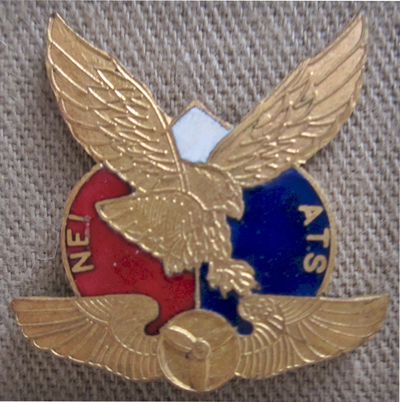 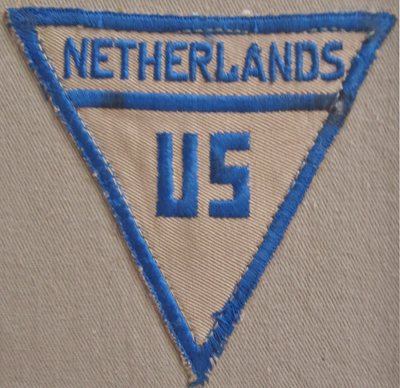
Added: 7/6/2014 - click on the image for larger versions
The metal badge is I think for a garrison cap.
The colours red, white and blue are those of the Dutch national flag.
The letters NEI stand in my opinion for Netherlands East Indies.
The letters ATS could mean Air Transport Squadron or Section.
The wing looks American style to me.
The sleeve badge came together with the above mentioned cap badge.
A theory is that both badges have something to do with a unit consisting of Dutch civilian pilots in US military service (5th Airforce USAAF) in Australia during WOII.
IDENTIFIED on 12/27/2020 by Tod Rathbone - The view on this was ATS stood for Advanced Training Squadron. Seeing it paired with the US civilian employee patch, makes me think it is related to Jackson Army Air Base, Mississippi, which was the home of the Royal Netherlands Military Flying School. Many ex-pat KNIL airman who escaped the NEI re-trained there.
|
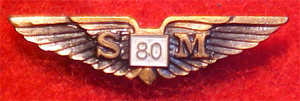  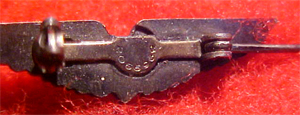
Added: 7/6/2014 - click on the image for larger versions
1" LONG, BRONZE OR BRONZE WASH, WHITE ENAMEL CENTER WITH "80", PIN-BACK WITH ROLLER LOCK, CENTER OF PIN MOUNT IMPRESSED "2066989", PATENT NUMBER FOR 1937.
|
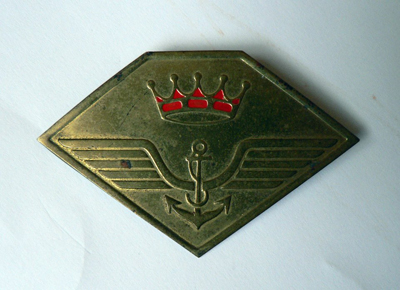 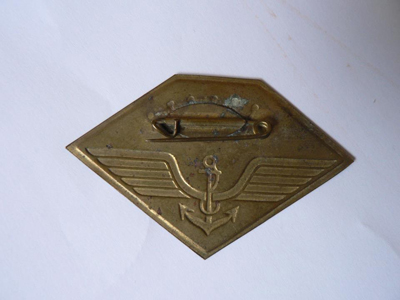
Added: 7/6/2014 - click on the image for larger versions
From a Spanish collector. No information attached regarding size or markings.
|
 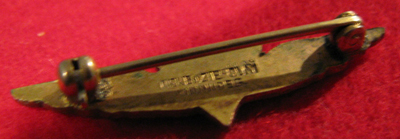
Added: 7/6/2014 - click on the image for larger versions
It came from Canada and is manufactured by Mackenzie Clay of Winnipeg. It is 33 mm long, so a very tiny wing. Was curious if it might have something to do with the BCATP?
IDENTIFIED on 03/03/2024 by Jerry Vernon via Jason Vanderhill- This MBA pin would most likely would be from MacDonald Bros.
Aircraft, widely known as "MBA", who were a major operation at the Winnipeg
Airport for decades, until sold to Bristol in 1954. Still operates at
Winnipeg as part of Magellan Aerospace.
RCAF Aircraft Record Cards show "MBA" for work done at MacDonald Bros.
Aircraft and later show "BAW" for Bristol Aircraft(Western).
See https://en.wikipedia.org/wiki/Bristol_Aerospace
They started out in the aircraft industry in 1930 building aircraft floats,
doing overhauls, etc.
Note that MBA had 4,500 employees by the end of the war. Among other things,
they built wings for Avro Ansons and assembled 319 Anson MK. IIs and 748
Anson Mk. Vs themselves from fuselages, etc. built by other companies in the
Anson production group known as Federal Aircraft Ltd.
Postwar, MBA/Bristol/Magellan were the major overhaul contractors for RCAF
Mustangs, Mitchells, Voodoos, CF-5s, CF-18s, etc. They are still a major
subcontractor building everything from components for Boeing airliners to
parts for F-35s.
At the back of the book "50 Years of Technology 1930 -
1980 - Volume One, The First Quarter Century", published in 1980 by Bristol
Aerospace Ltd. there is a list of known employees in the first 50
years of the company, and it mentions pins and shows some very small black
and white images. They issued 10, 15 and 20-year service pins, then a watch
after 25 years. They show small images of 5 different types of pins. Some
have "MBA" on them and others have the full company name. Three of the
pins have a set of wings as a background, but a different style of wings.
Some have the number "10", "15" or "20" in the centre. The closest pin has
a square in the middle with "MBA" vertically. I would guess that this pin
you have is just an ordinary company pin, not a special anniversary pin.
|
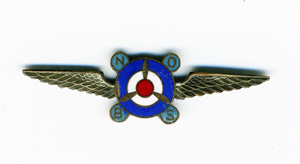 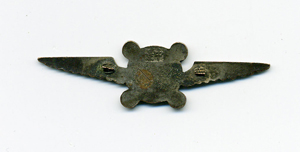
Added: 12/27/2012 - click on the images for larger versions
This wing is 1 7/8 long, its made of copper with a silver wash. It has Chinese? letters stamped into the back.
IDENTIFIED on 12/28/2012 by Matt Cybulski - The pin is for The Noble Order of British Spitfires (NOBS). It was a charitable organization formed in Shanghai China at the outbreak of WW2. They had a war drive effort to raise money to buy a Spitfire.
|
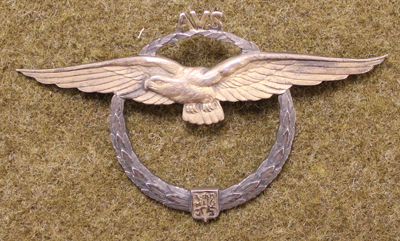 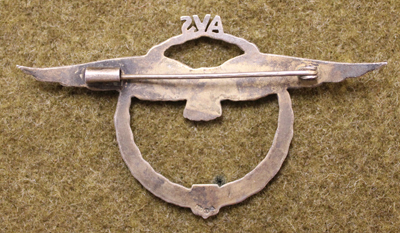
Added: 12/9/2012 - click on the images for larger versions
Czech badge - It is Hallmarked – KK and 900.
IDENTIFIED on 12/30/2012 by Radek Palicka - It is pilot badge for civil motor pilots who were trained and flew at AVS Praha which is abbreviation for Aeroklub Vysokoškolského Sportu Praha (Aeroclub of academic sport ). This aeroclub existed from late 1920s
till 1939 and again from 1945 till 1950. This aeroclub trained pilots mostly from Prague Technical College. This badge was issued and worn from mid 1930s till 1939. It was also awarded and worn during post war
period of the aeroclub's existence but most probably the only pre war supplies of this badge were used. The firm making them was KK (Karnet-Kyseley) and from .900 silver
It is very nice and rare badge even here in Czech!...
|
 
Added: 10/24/2012 - click on the images for larger versions
An unknown eagle pin made in silver which may have been worn by a World War 1 pilot from France but most of the ones similar to it were made by FIX. . . but this one has
no makers mark on the back. Its measurements are 2 15/16" wide X 1/2" high.
|
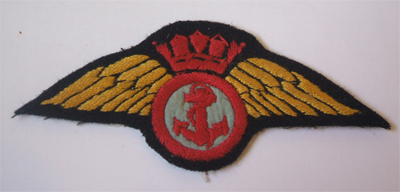 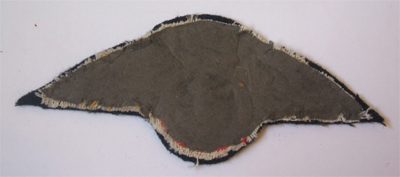
Added: 12/11/2011
These wings belonged to Lieut George W. H. Knott, Royal Naval Volunteer Reserve Auxiliary, Fleet Air Arm who was a pilot on HMS Indomitable (Click here to see his FAA pilot wings and his photo). The details are all woven silk and it measures 11.5cm x 5cm or 4.5inches x 2 inches.
IDENTIFIED on 12/26/2012 by Ian Harrison. The central device of these wings is the red fouled anchor on a light blue background edged by a red circle. This is the badge of the British WW2 "Beach Groups", and I know (because one of the Beach Groups had a Penguin as its formation badge - BECAUSE IT DIDN'T HAVE AN AIR WING) that most of the Groups had Air Wings. These may have been carrier based, or even Fleet Air Arm on the south coast of England for D-Day (?) and this ties in with the red Royal Navy crown worn over the Beach Group badge. I suspect therefore that this is is an unofficial British WW2 Beach Group Air Wing badge.
|
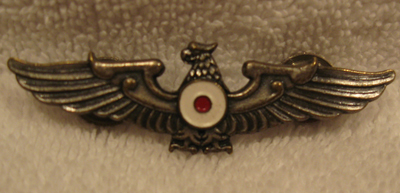
Added: 12/11/2011
It has two screwbacks and is approximately 2" wide. There is no writing on the back.
|
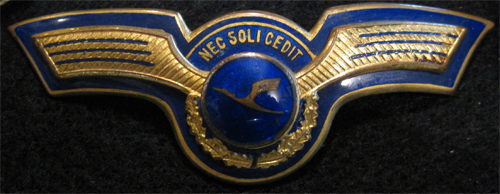 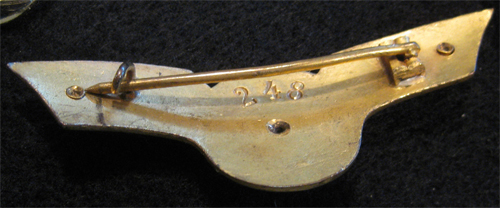
Added: 2/20/2011
This is a Lufthansa badge but the owner is looking for anyone who has any information on it who wore it or what its purpose was.
Additional information provided on 5/14/2011 by Gerry Stevens. "The Deutsche Lufthansa wings shown is for pilots before the Second World War. It was introduced circa 1932-33. There was also a version in embroidered wire. The serial number on the reverse is the issue number and would have identified the pilot concerned. However, Lufthansa’s records were destroyed during the war. I have badge number 48. The manufacturer is Paul Kust, Seydelstrasse 192, Berlin SW 19. The motto comes from the Palace of Sans Souci, the residence of Frederick the Great of Prussia. It means ‘I will not leave the sun’. "
|
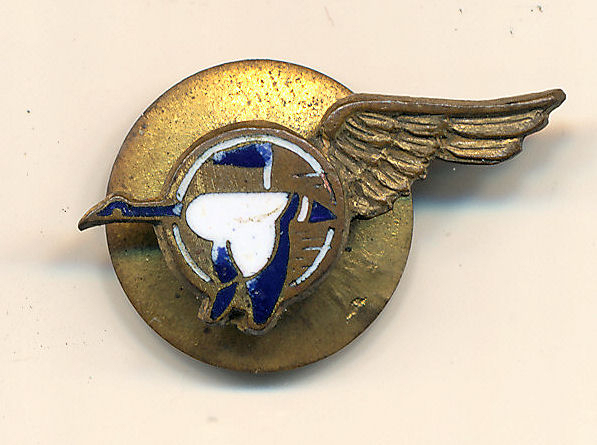
Added: 2/5/2011
|
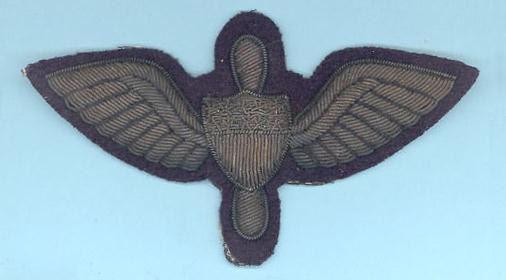
Added: 1/6/2011
It is quite large, measuring 4 7/8" wide X 2 11/16" high.
IDENTIFIED on 2/16/2011 by Ron Willis. Chief Petty Officer Airship Badge - See page 51 of "Navy Wings of Gold" for more info.
|
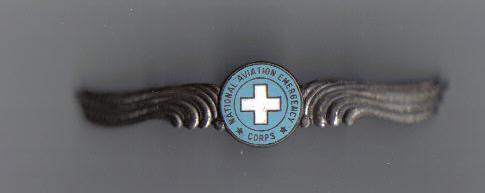
Added: 12/11/2010
It reads "National Aviation Emergency Corps"
|
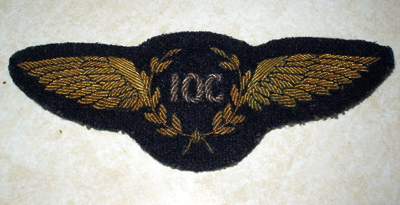 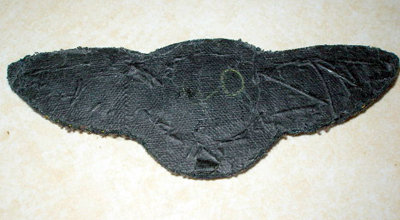
Added: 12/11/2010
IDENTIFIED on 2/5/2011 by Todd Evans. "those woven IOC wings added 12/11/2010 are International Order Of Characters Wings" http://en.wikipedia.org/wiki/International_Order_of_Characters
|
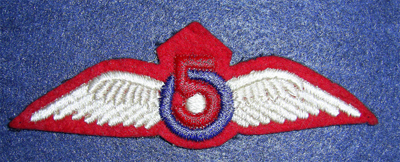
Added: 12/11/2010
POSSIBLE IDENTIFICATION on 2/5/2011 by Patrick Frost. "The one with a "5" on a RAF style wing is likely an instructor wing for the No.5 EFTS school. These were Elementary Flight Training schools in Canada used as part of the BCATP (British Commonwealth Air Training Program)."
|

Added: 10/8/2010
It is definitely pre-1919, has a screw back fastener and measures only
3/4" wide.
Backmarked: STERLING
IDENTIFIED on 12/11/2011 by Ed Beatty. "These wings were sponsored by 'Air Trails" magazine during the late 30's through the 40's. A monthly feature of the magazine was the 'Solo Club'. It dealt with sujects on learning to fly, etc. Any readers of the article were, upon making their first solo flight, entitled to a pair of these wings by mailing in a coupon which was part of the article, along with one thin dime, and proof, such as a certified log book entry, that they had indeed accomplished this feat."
|
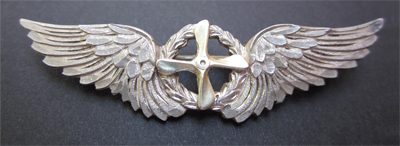
Added: 9/2/2010
It might be a cap badge for an Enlisted Pilot or sweetheart pin.
Appears to have been made by Robbins of Attleboro, MA
Two piece, die struck construction, measuring 1 15/16" wide.
Back marked STERLING, and the four bladed prop has a gold wash.
|
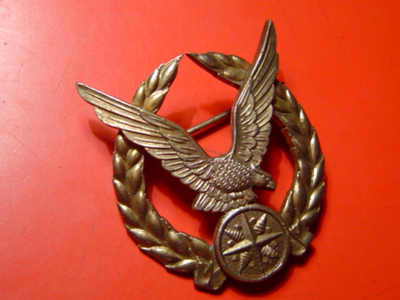
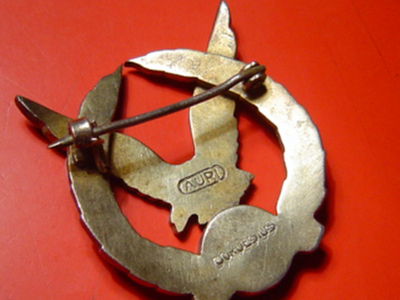
Added: 2/24/2010
"I was however , unable to find info on an unknown insignia I have had for some time , I have taken the liberty to include 2 pictures ; size = 40 mm. high ..
The firm of CORDESIUS was Dutch , best known for their KNIL insignia made in Dutch Indies BATAVIA , but possibly they made foreign insignia as well ?
This is not an insignia that I know to be either Dutch or Dutch Indies - possibly early post WW2 Indonesia , but I have no further info on those - if you have any suggestions , I would highly appreciate them ."
IDENTIFIED on 4/4/2010 by Frans Scale. "AURI was the name of the Indonesian Airforce from 1945 till 1974 and stands for: Angakatan Udara Republik Indonesia. This means Airforce of the Republic Indonesia. I think it is (was) a wing for observers."
|
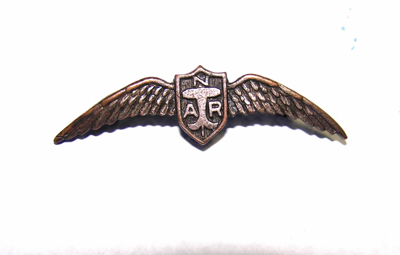
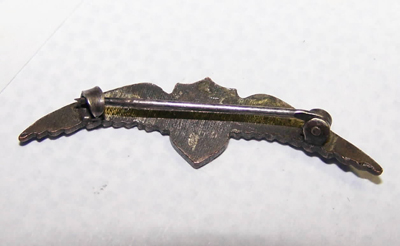
Added: 2/24/2010
It measures 4 cm long. It is unmarked, and appears to at one time to have been coated in silver (much has worn off.) The sheild in the center has what looks like a WWII era plane, with the letters N A R (or ANR). Any help would be appreciated.
IDENTIFIED on 9/19/2010 by Cliff Presley. "This is a novelty item sold at the National Air Races"
|
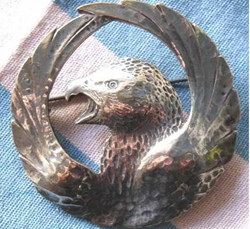
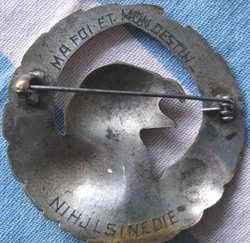
Added: 5/18/2009
On the back it has two inscriptions in french: 'Moi foi et mon destin' on the top half and NIHJLSINEDIE??? on the lower half.
|
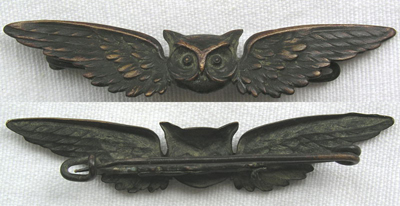
Added: 4/6/2009
It measures 85 x 14 mm, it is made of bronze and it is seemingly very old; my guess is WWI or the 1920s period. It was found in France, in a set together with a French 1920s pilot badge, but it is obviously NOT any French regimental badge/wing (it had been suggested that it had something to do with one of those night-fighter units that was formed during WWI). I understand that there are theories that it might be an (unofficial) US WWI wing, maybe for observers.
|
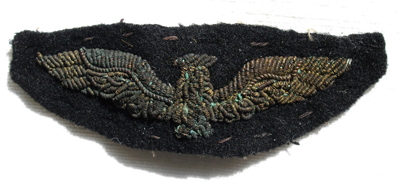
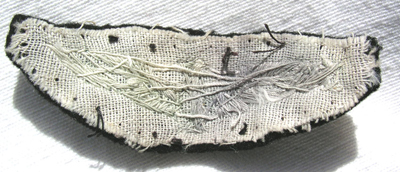
Added: 4/6/2009
Bullion wing on black backing, bought in Italy and assumably an Italian (or at least southern European?) wing - either for wear on uniform or on a cap. It is a golden bullion embroidered eagle with spread wings, facing right, on a black felt backing. The patch measures 81 x 27 mm.
|
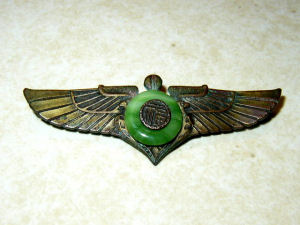
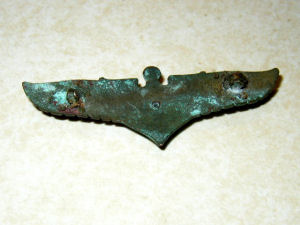
Added: 2/12/2006
Small Chinese characters in the center surrounded by Jade. "The chinese character is the word 'Fook' which means 'Good Fortune' and the whole Jade and 'Fook' medallion centre is a very common design for chinese jewellery and you can find this design easily even today. I have never seen this on any military items and I do not think it relates to any military establishments. The wing itself is also of a design very different from the one used by the Chinese Air Force (in China and Taiwan) and since I do not know much about wings used by civilian airlines, I cannot say whether it is in fact an airline wing. So my conclusion would be either this is a piece of jewellery or this is a civilian wing with its original centre covered or replaced by a piece of jade jewellery (in fact, the chinese word in the centre slants slightly. The reason for doing this, if it is the later case, is unknown, although personally, I am more inclined to believe it is merely a piece of jewellery." - Chan Hon Ying
|
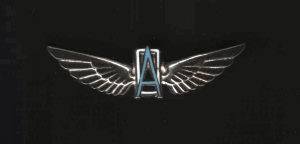
Added: 12/01/2005
A silver metal wing about 50mm wide. It has in the center an "A" in blue enamel superimposed on an "O" in white enamel. The back has a brooch pin fixing and hallmarked to J.Gaunt London.
IDENTIFIED on 12/26/2012 by Steven Whyte. The wing belongs to Owen Air (Pty)Ltd, a private charter service formed in 1946 and still going strong today.
They were one of the many private charter companies formed in South Africa post WWII by ex South African Air Force staff.
Owen air was originally based at Youngsfield Aerodrome, Wynberg (Cape Town) and used the wing from that period well into the 1960’s. They are now based at the Cape Town International Airport.
|
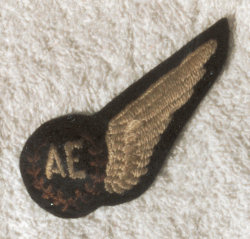
Added: 11/29/2005
IDENTIFIED on 11/30/2005 by Steven Haswell. "The wing added to the What Is It? section on 11/29/2005 is a relitavly modern Royal Air Force aircrew wing for Air Electronics Operator or Air Electronics Officer. This wing was introduced on 6th January 1963."
|
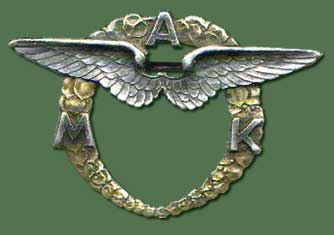
Added: 4/3/2005
IDENTIFIED on 4/5/2005 by Jan Sehnal. This is a Czechoslovakian badge, from the 1920´s, one of the aeroclub badges, MAK means Moravian Aero C(K)lub, Moravia is one of the districts of The Czech republic.
|
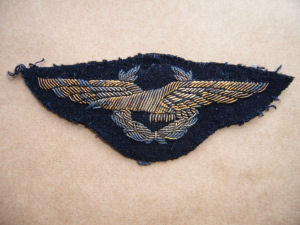
Added: 3/3/2005
IDENTIFIED on 3/26/2005 by several contributors. This is a Scandinavian Airline Systems pilot wing. The contributor notes that the pilot did fly for SAS after the war.
|
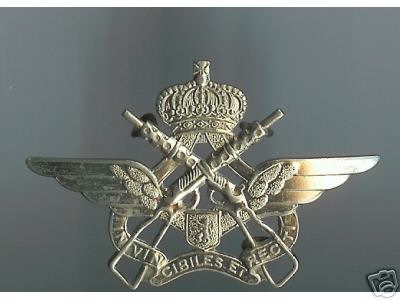
Added: 2/10/2005
IDENTIFIED on 2/11/2005 by both Gerard Afman & Chris Langley - This is a Belgian beret insignia of the Airfield Defense Unit. It is a post WW2 item.
|
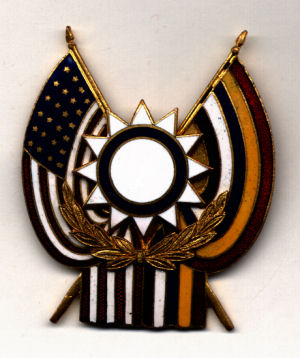
Added: 2/4/2005
Can anyone tell me what this hat badge is? It is from an American who served in China during and following WW2: Chinese sun symbol in the center. Flag on right is an early Chinese flag with 5 stripes used from 1912 to 1929. The five stripes represented 5 distinct peoples (with two different interpretations regarding the red and yellow stripes): Red=Manchurians (or Han), Yellow=Han (or Manchurians), Blue=Mongolians, White=Tibetans and Black=Muslims.
|
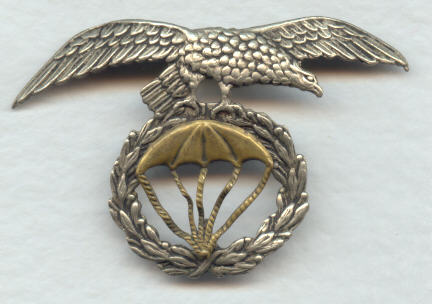
Added: 2/4/2005
The eagle is 2 3/4" long wingtip to wingtip. The entire insignia is 1 3/4 " tall from the bottom of the wreath to the eagle's back. The wreath surrounding the parachute is 1 7/8 " in diameter. The parachute is a separate 1" by 1" piece. The insignia is a hollow back design that attaches with three closed wire loops on the back (two on the eagle and one on the wreath).
IDENTIFIED on 2/10/2005 by both Jean Pierre Duriez & Gerard Afman - This is a Spanish Army Paratrooper beret badge
|
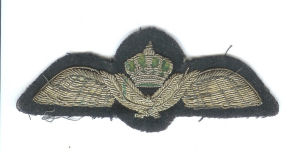
Added: 2/4/2005
IDENTIFIED on 2/4/2005 by both Chris Langley & Tod Rathbone - This is a pilot wing from the Kingdom of Jordon
|
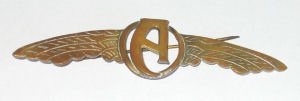
Added: 1/5/2005
It is 3 3/8" long, was silvered at one time.
|
 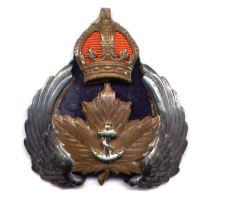
Added: 12/14/2004
Warren Carroll has opened a plea to see if anyone has a picture of cadets wearing these badges. Click either badge for a detailed background on them.
|
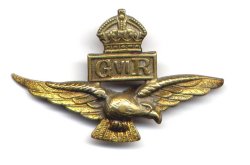
Added: 8/4/2004
Australian badge hallmarked K.G. Luke, Melbourne but what is it used for? Cap, collar?
|
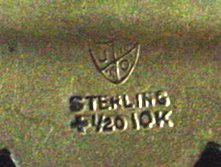 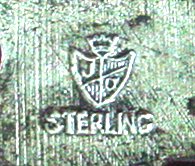
Added: 6/28/2004
This hallmark has been seen on both US Naval and US AAF pilot wings. To date nobody has been able to identify the maker. Any help would be greatly appreciated.
UPDATED ON 2/11/2017 - Thanks to some detective work from some fellow collectors and a trade card found with this insignia and the name of the company these are now being correctly identified as Josiah Odence marked badges.
IDENTIFIED on 8/4/2004 by Rob & Joe Quetel - On page 67 of "US Silent Service Dolphins & Combat Insignia 1924-1945" by David A. Jones, the J/O hallmark is identified as the J. O'Brian Badge Company located in Madison. New Jersey.
|
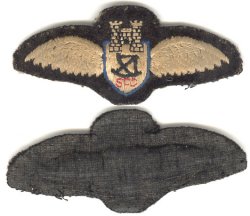
Added: 5/31/2004
IDENTIFIED on 8/21/2010 by Steve Haswell - This wing is from Sunderland Flying Club in the UK.
|
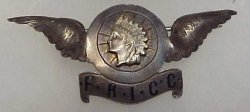
Added: 5/31/2004
The wing is 2 1/2" long with nice details hand chased into the wing design. The center has an indian head penny cut out and affixed over what appears to be a spoked wheel. The bottom scroll has black enameled letters: F.R.I.C.C. The wing is pinback and was made by J. Marrott/ Boston and is sterling marked.
|
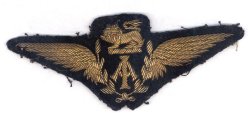
Added: 3/30/2004
It's 4.25 long with a wool base. It has a nice aged patina.
Identified on 5/31/2004 by Steve Haswell - Pilot wing for Imperial Airways
|
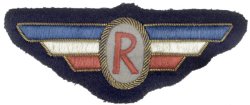
Added: 3/16/2004
About 10CM wide - silk embr. with bullion details - French?
Identified on 3/6/2019 by Glenn Murray - This badge is from the Robin Line steamship company. http://ianewatts.org/robin-line/
|
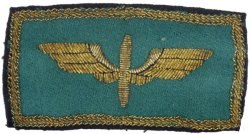
Added: 3/16/2004
About 10CM wide - i was told French but no ideas on it from French collectors!
Identified on 12/11/2011 by Jesse Ruiz Moreno - This is one of two shoulder epaulete set for gala uniform ( black color open jacket ) since 1963 till now in the rank for junior officers, SLt, Lt and Capt grades.
|

Added: 3/16/2004
About 10CM wide - nice gold wire embroidered on olive green gabardine.
Identified on 2/27/2016 - A man who had connections in Hollywood bought a few of these, along with some handmade RFC wings in cloth (not bullion) and sold some to me.
The RFC wings were nicely done, all slightly different owing to having been hand done and look like the ones in the Errol Flynn movie Dawn Patrol.
They were quite cheap, even for the 80's and were sold as reproductions.
The winged props on olive green looked to be machine made and were assumed to be used in movies for Italian WW1 air force or even possibly for use with French uniforms but doubtful as the background would not match any French uniform. These have been around for sale and are usually if not always uncut and never used on uniforms
|
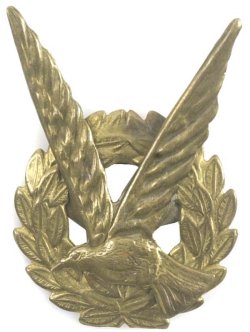
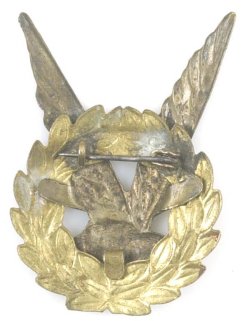
Added: 3/06/2004
Stamped brass, 2 pc. construction with thin pin. 35mm wide on wreath - 55mm tall. I've been told it's a pilot badge - also someone's air force cap badge. Any Ideas?
|
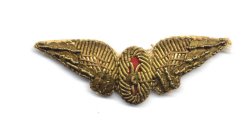
Added: 2/06/2004
2 1/2" wide
IDENTIFIED on 11/24/2019 by Robert Egeric -The winged wheel is a cap badge of the Royal Yugoslav Railway.
|
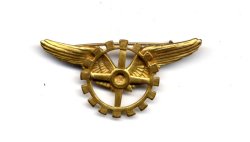
Added: 2/06/2004
Looks French made. Thin pin attachment with no hallmark.
|
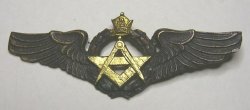
Added: 2/06/2004
Appear to be Bronze
Identified on 2/28/2004 by Chris Langley - Iranian Air Force Navigator wing from the Shah Rezah Pahlavi era - 1950's to 1970's
|
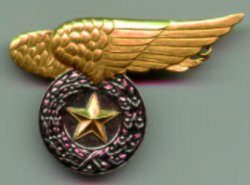
Added: 2/06/2004
French type badge
Identified on 2/9/2004 - South Viet Nam pilot at the time of the French Occupation. Probably Bertrand made. - Warren Carroll
|
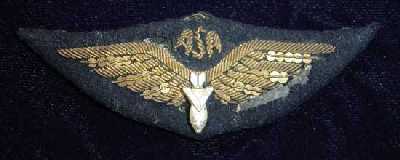
Added: 5/19/2003
|
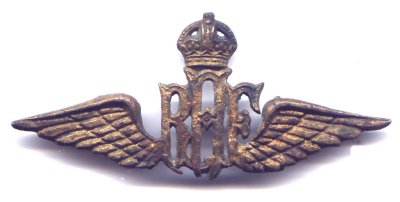
Added: 2/24/2003
It is sand cast in brass, 3 inches wide and has cast-in loops for a straight pin attachment. Appears very old. Probably a Bazaar badge, something made for a bush jacket or even a souvenir? It's last known home was India.
|
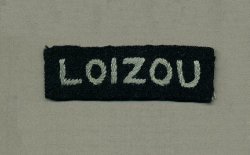
Added: 10/22/2002
This appears to be an RAF Other Ranks title but no country of Loizou can be found in research. Anyone have any info on this?
Airman Stephanos Piperoglou of the Hellenic Tactical Air Force wrote in with the following thoughts: "I ran into your WW2 wings site recently during the course of my work and spotted an unidentified "Loizou" badge. There is indeed no country named thus, but Loizou is a very common Greek-Cypriot surname. I would hazard a guess that the badge belongs to a member of the RAF of Cypriot origin named Loizou - Cyprus was a crown colony up until 1960, and indeed the current President of the island, Mr. Clerides, served in the RAF himself."
|
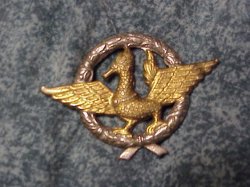
Added: 8/19/2002
Identified on 2/06/2004
Its Cambodian, a pilot from the traditionalist Khmer / FANK Regime of the 60's /70's.. Identified via NZ from a rather obscure book on Cambodian forces badges.
More information on this badge on 8/9/2004 - This emblem is the emblem of the pilots of the Khmers (Royal Cambodian Air Forces). This model is the one that was given to the young Khmer pilots for the sixth promotion, it was used in Cambodia after 1965. The bird in the center of the emblem is the Hansa or Han, the sacred goose mounting of Vishnou, one of the symbols of the Khmer monarchy. The markings on the back of the badge are alphanumeric which probably means this is a fake as the real badges carried only series of figures.
Lt Colonel S.Sisowath - former pilot of the Khmer Royal aviation.
|
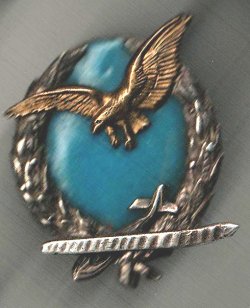
Added: 8/19/2002
|
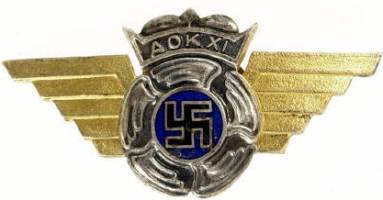
Added: 7/8/2002
Note: It's obviously Finnish but with the unusual combination of the "post-9/44" design with the swastika
Identified on 11/21/2004 by Matti Hietanen
It’s not a pilot wing but a course insignia. Those letters mean like warrant-officer-pilot-course XI. Private-service-courses had their own items/insignias. These wings are miniature size and not used on any uniform but on civilian wear.
|
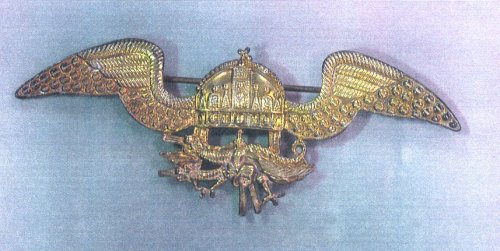
Added: 6/17/2002
Note: Gold wing with St. Stephan's Crown and 3 fire breathing dragons under the crown. This wing is belived to be from WW2 or just before the era. The wing has a WW2 type pin back. It measure 96 mm horizontally and 37 mm vertically.
Identified on 4/5/2009 - The St Stephan's Crown with wings n fire dragons, is probably an air gunners badge. In ww1, the Austro-hungarian army used the Crown over-fire-dragons as a machine-gun corps insignia. Hungarian and Austrian tropps had their own versions. - Justin Wheeler
|

Added: 6/3/2002
Identified: 2/24/2010 - Venezuelan flight surgeon. I would say 1940s to early 1950s. - Tod Rathbone
Note: Marked Russell, NYC on back
|
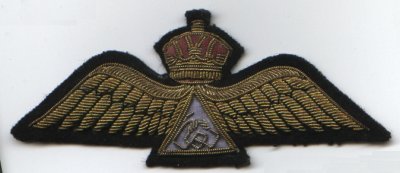
Added: 4/29/2002
Note: 4"x2"
Identified on 5/9/02 by Randy Scorby
This is a WW2 Iraqi pilot wing.
|
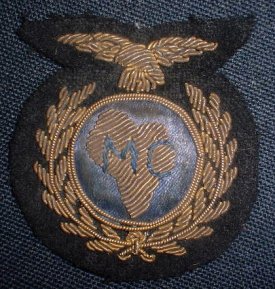
Added: 4/26/2002
Note: South African but for what use? Height 56mm, Width 52mm approx.
John Marking wrote in on 8/9/2004 to say: The gold embroiderd badge you have on your site with the wreath,eagle and gold map of Africa with the blue letters M.C. is very probably an airline associated with the British company well known in Africa, called Mitchell Cotts. Their shipping company flag is similar also with a blue flag , yellow map of Africa and a blue M.C.
|
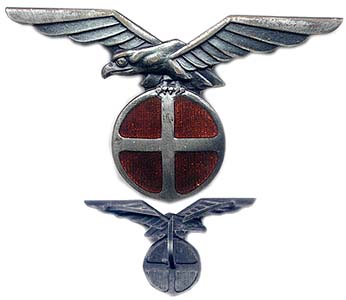
Added: 4/17/2002
Note: Possibly a Norweigan badge? Any help would be greatly appreciated.
Identified on 4/17/2002 by Warren Carroll, John Conway and Derek Carter
This is a cap badge for the members from Norway that joined the german forces under their own National units. It is a cap badge of the Nasjonal Samling (Norwegian National Unity Party) or
Nazi Party headed by Quisling.
Another site visitor writes: This falcon (not an eagle) is probably a replica since the orginal is in gold ,not with red enamel but with red paint. This type of falcon was worn by the Rikshirden,Quislings boys. Norwegians that collaborated with the Germans in WW2. 2000 of these Hirdmen joined the Waffen-SS for a year or more. They served in German SS uniforms, not Hirduniform.
|

Length: 4 inches
Width: 1 inch
Contributor: R. & J. Quetel Collection
Date Added: 9/24/01
Identified on 2/4/2003 by Andrew Butler
This wing is the U.S. Civilian Technical Corps see article in Vol 12 No.1 of 'The Military Advisor'
|

Length: 1 9/16"
Width: 7/16"
Contributor: R. & J. Quetel Collection
Date Added: 11/30/2001
Identified on 8/21/2010 by Joe Weingarten - The wing would be the same as our Civil Air Patrol.
|
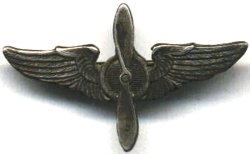
Length: 1 1/8"
Width: 11/16"
Hallmark: Sterling
Contributor: R. & J. Quetel Collection
Date Added: 11/30/2001
|

I have attached an unknown wing that is 2 1/4 inches long by 17/32" wide and is only marked 1/20 G.F. We looked in all the reference books we have including 2 books on airline wings, Kiddie Wings And Other Things by William Gawchik and Pilot Wings of the United States 1913-1995 Civilian and Commercial by Philip R. Martin, but we couldn't identify it.
IDENTIFIED ON 2/17/2002 by JJWINGS
This wing is an early Northwest Airlines radio operators overseas wing 1950/1970 also used by other male crew members like purser but was made for radio wireless operator.
ALTERNATE IDENTIFICATION ON 5/14/2011 by Derek Hughey
I believe this is a radio operator wing from American Overseas Airlines. American Overseas began as American Export Airlines in 1937. In 1945 American Airlines acquired them and changed the name ot American Overseas Airlines. In 1950, PAA acquired it from American. You can look at the airlines wings at www.stanwing.com to see that Northwest never had a wing that looked like this. American did, but then it is hard to know for sure whether these radio operator wings would have been worn by regular American Airlines or American Export, as their uniforms were very similar. Actually, the pilot wings were made by the same manufacturer. Since American Airlines acquired American Export in order to get into the European overseas markets, American Airlines probably had no radio operators on their aircraft at that time, because at that time, they didn't fly overseas, only the American Export Airlines portion did that flying.
|

I have this wing that I need to get identified. It is a civilian wing that I believe is cap sized at 2 1/8 inches wide. It is not marked on the back and has a white metal pin and drop in catch. I think it's 1930's vintage and the plane flying over the globe looks like a catalina. It might be Pan-Am or possibly TWA, or ?
IDENTIFIED 8/19/2001 by R. & J. Quetel:
From Hake's Price Guide to Character Toys 3rd Edition, the item is clearly identified on page 224, item CLP-2. "The 'China Clipper' mystique and adulation resulted in several tribute premiums issued by Quaker Oats." In this case the wing is a "1935 Quaker Puffed Wheat and Rice Brass Bar Badge", valued between "$20 to $75. For anyone not familiar with "premiums", a premium originally was an item that was either given away free or possibly there was a very nominal shipping cost to get it. There are all types of premiums ranging from autographed photos to watches. Although premiums have been around for a very long time, those of us familiar with the term are most familiar when it is in regards to radio shows and later television shows. They also make premiums items that advertise a company. Examples would be a Tropicana "Orange" radio or a Ritz Cracker wristwatch. These items have to be purchased, but today they are also classified as premiums. The idea was for a company, usually a sponsor to the program, to give an item relating to the show so that you would buy their product to get it. Radio shows such as Buck Rogers, Batman, Jack Armstrong, The Lone Ranger, Tom Mix, Space Patrol, and Superman are just a few of the programs who had sponsors that gave away premiums. Although not all sponsors were makers of cereals, many were. Well before this gets to be a long letter, at least the item has been properly identified. If anyone is interested in premiums, let us know and we'll give them a list of books that are on the subject.
Rob & Joe
|

